|
I have been praising Sindhi hospitality continuously since my trip, to anyone who will listen to me, and one of the examples I often give is that almost everyone I met in Sindh offered to serve me tea. Not only friends and family whom we visited intentionally, but also strangers we met in the street, shopkeepers in bazaars, doctors in hospitals, all offered us tea and eagerly served it if we said yes. At this point, I have often received the question, “why on earth were you visiting hospitals?” It would not have occurred to me to ask that question, but perhaps it deserves answering. It also affords me the opportunity to step out of chronological order in my travelogue to recount some different experiences, which, though brief and unglamorous, were just as important to me in my trip as the visits to the major sights of Sindh. And there are many reasons for my interest, the simplest of which is that a very large number of my Pakistani friends are doctors, including Papa Saeed and most of my Sangi siblings. For a long time I have been observing them and the conditions in which they work from a distance (via FB). In visiting my Sindhi friends and family, I wanted more than anything to see them in their natural settings, how they live and work, to get a sense of the rhythm of daily activities and the atmosphere of life. I wanted to see all the things that simply seem normal and unexceptional to them, because those were the things that were least normal and most exceptional to me as an outsider. Hospitals and healthcare settings are also of special interest to me, because I am someone who has had to spend far more time than I would have liked within my own (American) healthcare system. I myself have suffered and have lost very long stretches of my life to an autoimmune disease. Thankfully that illness has been under control for the last several years, but the years of suffering give me an unusual perspective on the world. I am more familiar with physical pain and fatigue than most people of my age, and this despite the benefit of extremely advanced treatments and world-class doctors. I am also fortunate enough to have emerged from that difficult period with most of my energy and all of my joy intact. And this is a kind of hope that I would love to give to other people who are suffering, whether it be from illnesses similar to mine or completely different. So it is from that perspective that I approached my visits to several different hospitals in Sindh on my first trip, and I hope to visit more in the future. It is very important to note that my experiences so far are limited to the places I visited, and the time I spent there short. At this point I am only recounting my personal observations. So the context is subjective, but I try to look deeply and honestly, so perhaps I can begin to open a window and offer some new light in which to think about it healthcare in Sindh. 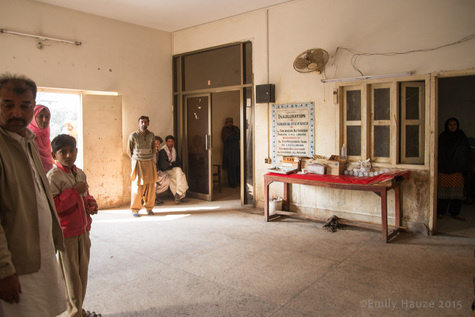 Entryway of the pediatric hospital--curious eyes watching me. Entryway of the pediatric hospital--curious eyes watching me. One morning towards the end of my stay in Larkana, Papa Saeed and I set out in the car toward the pediatric hospital to see if we could surprise our friend Hafeezullah, who is one of the surgeons there. We pulled in at what I think was a back entrance--at least, it didn’t seem like a main entrance. It was a humble, shady entryway, and the building seemed sturdy but worn. The facility felt well-loved, but over-taxed. The lobby area was quite dim, especially because there was no electricity at this moment. All Pakistanis are used to variability in their electricity, with scheduled load-shedding (intentional power cuts) as well as unscheduled losses of power repeatedly throughout the day. Even hospitals, as I found out on this day, are not exempt from the plight of load-shedding. 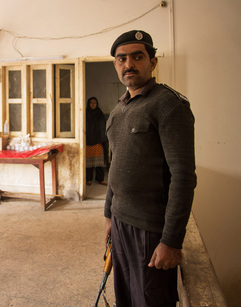 One of our guards. One of our guards. The patients and their families waiting in the hallways seemed to come from the lower classes, dressed simply but in the bright colors that always delight the eye in Sindh. Well, the colors are worn by women. Men tend to wear neutral colors apart from the occasional ajrak, worn about the shoulders or tied around the head in a turban. I saw one such man there in the lobby, of indeterminate age, was wearing a tattered white shalwar kameez and a faded ajrak turban, all of which set of a striking contrast against his dark skin and piercing light blue eyes. These were true blue eyes, bluer than mine and just as bright, set incongruously into a weathered-looking face that seemed to have seen countless trials. Perhaps he was there with his child. Of course, no one goes to a hospital to have a good time. I didn’t have time to linger and take photos in the lobby area--we were quickly on our way up the stairs toward the operating rooms. But my presence and Papa’s never goes unnoticed, wherever we go. Papa is well known throughout the medical community in Larkana, so he is greeted and reverenced wherever he goes. And I, even when dressed in Pakistani clothes, am immediately perceived as something exotic. Fortunately for me, it is never assumed that I am American until Papa says so: “muhnjee amreeki dhee ahey!” (“She’s my American daughter!”) And all the eyes of the whoever is gathered nearby turn to look at us, wherever we pass. In the hospital as everywhere else, those eyes were full of warmth and curiosity, which I attempted to return in kind. Once upstairs, we found that Dr. Hafeezullah was not at work today, having taken leave and gone with his family on vacation. We wanted to inquire with a supervisor as to when Hafeez would be returning, and of course Papa was asking these questions in Sindhi, with me understanding only every fourth or fifth word that was spoken. I followed Papa and another doctor wherever they were leading, and was instructed to take off my shoes and put on a pair of slippers that was set on the floor. I did as I was told, not yet realizing that we were actually right outside the two operating rooms. When I looked up I found that we were in the doorway of a room in which a surgery was currently taking place, some 15 or so feet away from us. And here also it was dark--there was no electricity even in the operating room. The surgeons, deep in concentration, were having to perform their operation only using light from a large window near the operating table. No electrical machines appeared to be operating at all; I am given to understand that there are generators, but that even they are not reliable. We found a very similar scene in the other operating room. Surgeons in mid-procedure, operating without light and without any of the elaborate mechanical apparatus that I would have expected. In both rooms I took quick photos from the doorway. Knowing that we should not distract the surgeons any further, Papa and I took our leave. 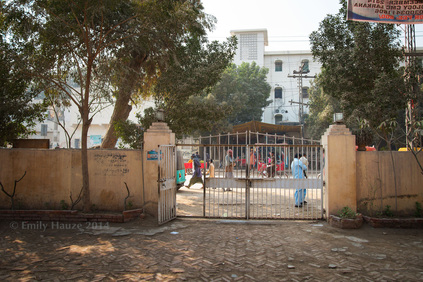 View out the gate at the pediatric hospital. View out the gate at the pediatric hospital. (Side note to anyone who might be wondering. Papa called Hafeezullah on his cell phone soon after this, and reached him where he was vacationing in Lahore with his family. I told Hafeez that it was a shame to miss him, but that it was no problem, and he should enjoy his vacation. But much to my surprise, he decided to cut his vacation short by a day or two and return to Larkana before I left, to visit with me and Papa and give me a few Sindhi gifts. Sindhi hospitality is always extreme in this way -- always going yet a step further than expected to show affection to guests.) We left the pediatric hospital to attempt a different visit, to Dr. Zafar Ali Pirzado, a close friend of Papa’s and an uncle (chachu) to me. As usual we were being accompanied by a security detail--a smaller one this time, just two guards, I think, though highly armed as usual. They preceded us down the bright and open lane that enters the campus of what used to be called Chandka Medical College in Larkana. (It has now been subsumed in the larger institution of SMBBMU, a cumbersome acronym that stands for Shaheed Mohtarma Benazir Bhutto Medical University. Shaheed = martyr, Mohtarma = respected lady.) Papa Saeed was a professor of cardiology here until his recent retirement, and so we were warmly greeted by even more than the usual number of medical colleagues who know and admire him. 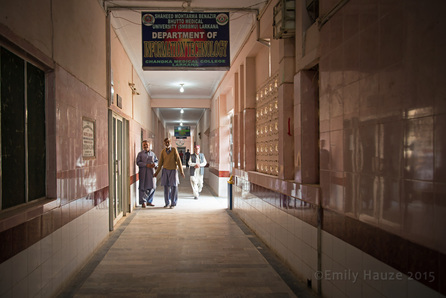 Hallway of SMBBMU Hallway of SMBBMU I didn’t see the entire campus, but the building that we entered was large and elegant, with a clean, spare, minimalist aesthetic. The marble hallways were breezy and cool, though of course it was January. Classes were not in session, so the hallways and courtyards were quiet and felt expansive. The couple of classrooms and technology labs that we visited had no light, but that was likely a prudent electricity-saving measure, as opposed to a woeful deprivation. There was a faction of discontent, however, on this otherwise placid campus. A group of forty or so medical students had planted themselves on rugs on the ground right at the entrance of the university. As we passed them in the car, I asked Papa why they were protesting. “YOU WANT TO TALK TO THEM, SWEET EM?” he offered. 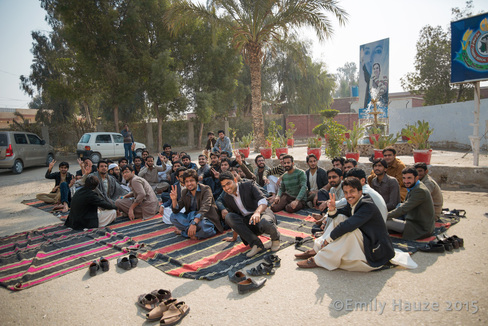 The otherwise discontent protestors. The otherwise discontent protestors. I was hoping to get a photograph of them looking angry and defiant, but as soon as I stepped out of the car they were all smiles and curiosity. I actually asked them to return to their previous angry look for the sake of the camera, but it was impossible. The spirit of friendliness had overtaken them. Thus the photos I got look more like an impromptu picnic than a protest. But a few of the students stood up to come and explain to me why they were protesting. They explained (if I remember correctly) that there had been unjust dealings when it came to their examinations. The details were unclear to me, but nepotism and corruption seemed to be at the core of it. Some students were being favored with the opportunity to take exams (perhaps extra times) when others were not. Certain professors on the faculty seemed to be the root of this corruption. But one of the students was quick to note, “Professor Sangi was never one of these corrupt faculty members! He is a good man.” I thanked them and wished them good luck, and we were back in the car towards the building where Chachu Zafar has his office. He knew that I was in town, but didn’t know that we were coming on this day. We found him sitting at his desk in his office, an airy space with high ceilings and a crisp, spare elegance. The joy on Chachu’s face was radiant when we surprised him in the doorway. “I cannot believe it!” he exclaimed. “I never would have thought that I would see my own daughter here, before my eyes.” The language around the idea of family in Sindh is fluid in this way: I call him “uncle,” but he calls me “daughter” (beti). But this fluidity is not a sign of weakness, but rather of the intensity of the emotion that is felt between familial relations. Using different words to address relations has a way of elevating and honoring them, while also indicating how close they are to the heart. And these words have deep meaning. I could feel it even before my trip to Sindh, that there was a genuine emotion present when Sindhi people call me adi (sister) or beti. But the depth and warmth of that emotion were not fully apparent to me until I came to Sindh. This meeting with dear Chachu Zafar is a perfect example. He had never meet me in person before, and had only had small interactions with me on Facebook, apart from observing my communications with Papa Saeed. But there could be no doubt of his love and sincerity when he called me ‘daughter.’ He put his hands on my head in blessing. And then he invited us to sit, and served us tea. Post Script. I am ending this blog entry here for the sake of time and length, but I do have a few more vignettes from different hospital settings to recall in future blog entries. Particularly my visit to the Taluka Hospital Sakrand, where I got a glimpse of women’s healthcare in Sindh. But I will save that for a future entry focusing on women’s issues. I do want to include this one stray scene before I close. This is from a different day, when I visited the ER of the hospital which Papa Saeed used to work, and where he is very well known. This is one of his patients, greeting him with love and gratitude. I witnessed many people greet Papa in this way. The reverence is unmistakeable.
5 Comments
|
Image at top left is a digital
portrait by Pakistani artist Imran Zaib, based on one of my own photographic self-portraits in Thari dress. AuthorCurious mind. Archives
September 2020
Categories |
emily s. hauze
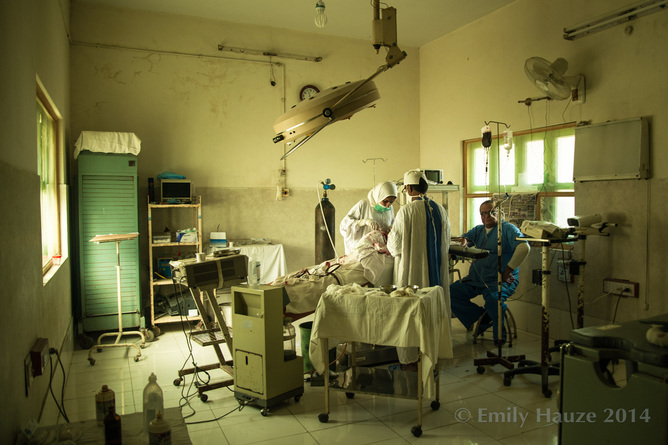
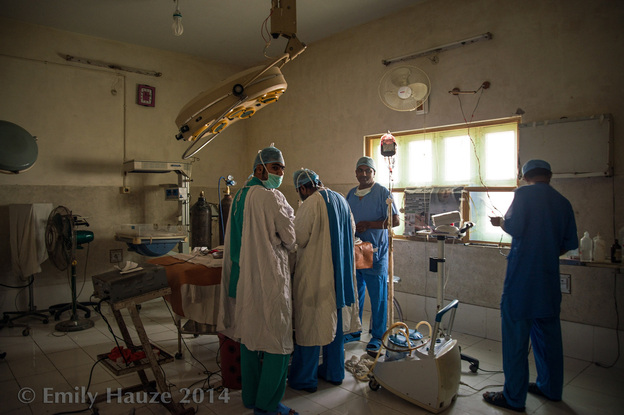
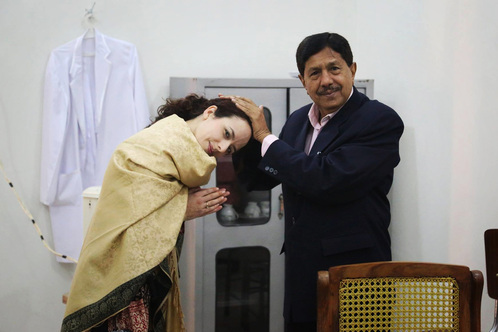
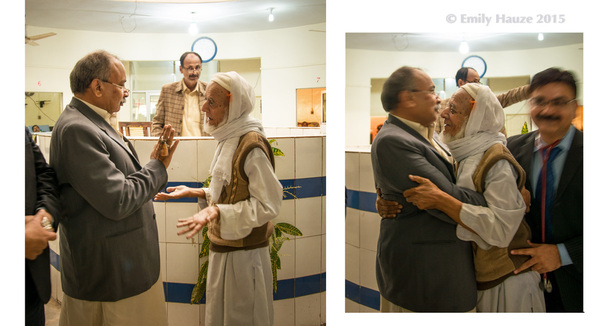
 RSS Feed
RSS Feed
